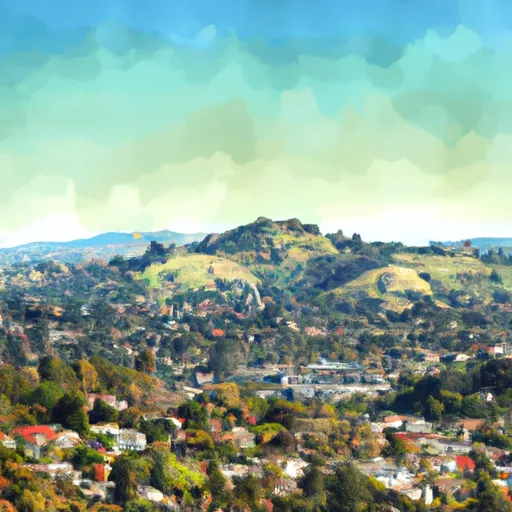-
 Snoflo Premium
Snoflo Premium
Get unlimited access to all our content
With no Ad interruptions! - Start Your Free Trial Login with existing account
Mount-Hamilton
Eden Index
Climate
9.8
•
Recreation
3.8
•
Community
•
Safeguard
5.2/10

Mount Hamilton is a mountainous region located in Santa Clara County, California. Situated in the Diablo Range, this area is known for its diverse climate, stunning landscapes, and abundant outdoor recreation opportunities. The climate of Mount Hamilton is influenced by its elevation, which reaches approximately 4,200 feet. Summers tend to be relatively mild and dry, while winters can be cold and wet, occasionally bringing snowfall.
Hydrology constituents in the region include the presence of creeks and springs, which contribute to the overall water supply. The primary source of water in Mount Hamilton is the South Bay Watershed, which includes streams like Smith Creek and Quimby Creek. These waterways not only provide a vital resource for the local ecosystem but also offer opportunities for recreational activities such as fishing and picnicking.
Outdoor enthusiasts are drawn to Mount Hamilton for its excellent hiking, mountain biking, and wildlife viewing opportunities. The area boasts several trails, including the popular Mount Hamilton Grand Loop, which showcases breathtaking views of the surrounding valleys and mountains. Additionally, the Mount Hamilton Observatory, located near the summit, offers visitors a chance to explore the world of astronomy and enjoy stargazing events. Whether it's hiking, wildlife spotting, or stargazing, Mount Hamilton provides a picturesque backdrop for outdoor recreation enthusiasts.
What is the Eden Index?
The Snoflo Eden Index serves as a comprehensive rating system for regions, evaluating their desirability through a holistic assessment of climate health, outdoor recreation opportunities, and natural disaster risk, acknowledging the profound impact of these factors on livability and well-being.
Climate Health Indicator (CHI): 9.8
Mount-Hamilton receives approximately
614mm of rain per year,
with humidity levels near 60%
and air temperatures averaging around
14°C.
Mount-Hamilton has a plant hardyness factor of
9, meaning
plants and agriculture in this region tend to thrive here all year round.
By considering the ideal temperature range, reliable water supplies, clean air, and stable seasonal rain or snowpacks, the Climate Health Indicator (CHI) underscores the significance of a healthy climate as the foundation for quality living.
A healthy climate is paramount for ensuring a high quality of life and livability in a region, fostering both physical well-being and environmental harmony. This can be characterized by ideal temperatures, reliable access to water supplies, clean air, and consistent seasonal rain or snowpacks.
Weather Forecast
Streamflow Conditions
San Francisco Bay
Area Rivers
San Francisco Bay
Snowpack Depths
San Francisco Bay
Reservoir Storage Capacity
San Francisco Bay
Groundwater Levels
Recreational Opportunity Index (ROI): 3.8
The Recreational Opportunity Index (ROI) recognizes the value of outdoor recreational options, such as parks, hiking trails, camping sites, and fishing spots, while acknowledging that climate plays a pivotal role in ensuring the comfort and consistency of these experiences.
Access to outdoor recreational opportunities, encompassing activities such as parks, hiking, camping, and fishing, is crucial for overall well-being, and the climate plays a pivotal role in enabling and enhancing these experiences, ensuring that individuals can engage in nature-based activities comfortably and consistently.
Camping Areas
| Campground | Campsites | Reservations | Toilets | Showers | Elevation |
|---|---|---|---|---|---|
| Grant County Park | None | 1,645 ft | |||
| Henry Coe State Park | 20 | 2,715 ft | |||
| Uvas Canyon County Park | 25 | 1,098 ft | |||
| Coyote Lake County Park | 74 | 796 ft | |||
| Mount Madonna | 111 | 1,583 ft | |||
| Sunol Regional Wilderness | None | 529 ft | |||
| Carnegie State Vehicle Rec Area | 23 | 602 ft | |||
| Del Valle Regional Park | 150 | 760 ft |
Catastrophe Safeguard Index (CSI):
The Catastrophe Safeguard Index (CSI) recognizes that natural disaster risk, encompassing floods, fires, hurricanes, and tornadoes, can drastically affect safety and the overall appeal of an area.
The level of natural disaster risk in a region significantly affects safety and the overall livability, with climate change amplifying these risks by potentially increasing the frequency and intensity of events like floods, fires, hurricanes, and tornadoes, thereby posing substantial challenges to community resilience and well-being.
Community Resilience Indicator (CRI):
The Community Resilience Indicator (CRI) recognizes that education, healthcare, and socioeconomics are crucial to the well-being of a region. The CRI acknowledges the profound impact of these elements on residents' overall quality of life. By evaluating educational resources, healthcare accessibility, and economic inclusivity, the index captures the essential aspects that contribute to a thriving community, fostering resident satisfaction, equity, and social cohesion.

